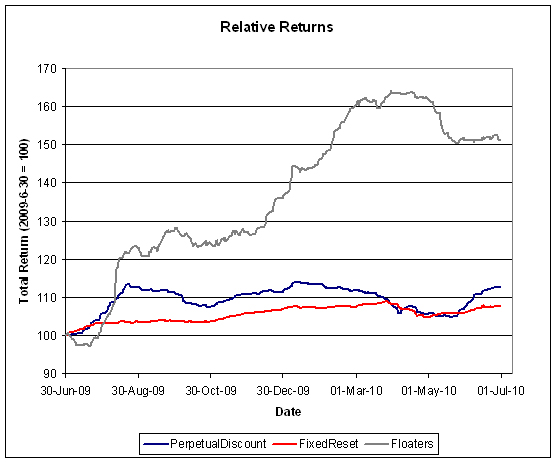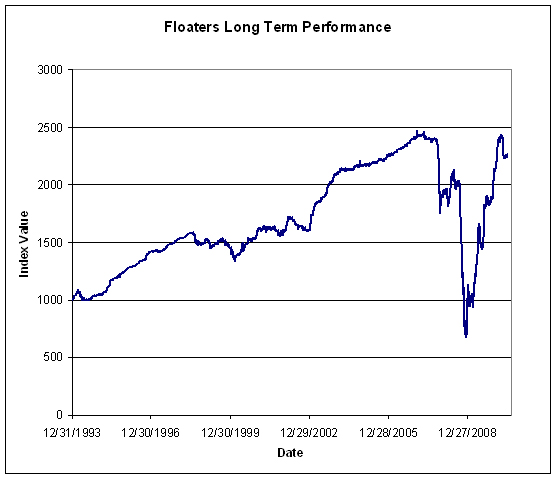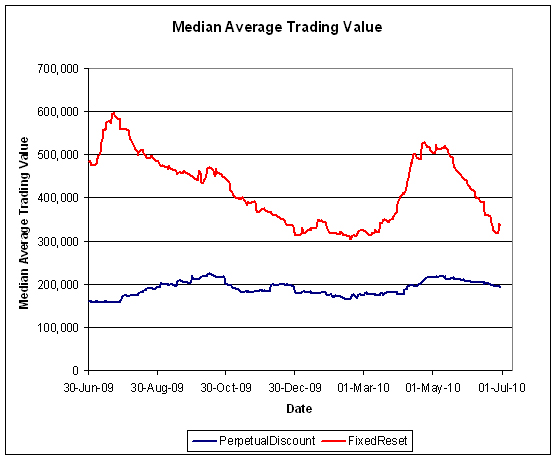The fund had a very good month in June, outperforming all the relevant indices and passive funds as the Seniority Spread (interest-equivalent PerpetualDiscount yield less the yield on long corporates) declined significantly from 315bp on May 31 to 290bp on June 30. The spread narrowing was not the only part of the story, however, as long corporate yields declined from 5.65% to 5.45%.
The fund’s Net Asset Value per Unit as of the close June was $10.5770 after a dividend distribution of $0.143686 per unit.
| Returns to June 30, 2010 | |||
| Period | MAPF | Index | CPD according to Claymore |
| One Month | +5.49% | +2.87% | +2.59% |
| Three Months | +4.60% | +1.17% | +1.33% |
| One Year | +20.72% | +12.67% | +9.02% |
| Two Years (annualized) | +31.02% | +6.05% | +4.17%* |
| Three Years (annualized) | +17.96% | +2.47% | +0.44% |
| Four Years (annualized) | +14.64% | +1.77% | |
| Five Years (annualized) | +12.55% | +1.96% | |
| Six Years (annualized) | +12.09% | +2.71% | |
| Seven Years (annualized) | +13.24% | +2.93% | |
| Eight Years (annualized) | +12.45% | +3.55% | |
| Nine Years (annualized) | +12.78% | +3.50% | |
| The Index is the BMO-CM “50” | |||
| MAPF returns assume reinvestment of dividends, and are shown after expenses but before fees. | |||
| CPD Returns are for the NAV and are after all fees and expenses. | |||
| * CPD does not directly report its two-year returns. The figure shown is the square root of product of the current one-year return and the similar figure reported for June 2009. | |||
| Figures for Omega Preferred Equity (which are after all fees and expenses) for 1-, 3- and 12-months are +3.01%, +1.35% and +11.46%, respectively, according to Morningstar after all fees & expenses | |||
| Figures for Jov Leon Frazer Preferred Equity Fund Class I Units (which are after all fees and expenses) for 1-, 3- and 12-months are +2.74%, +0.66% & +7.33% respectively, according to Morningstar | |||
| Figures for AIC Preferred Income Fund (which are after all fees and expenses) for 1-, 3- and 12-months are +3.12%, +0.20% & +7.08%, respectively | |||
MAPF returns assume reinvestment of dividends, and are shown after expenses but before fees. Past performance is not a guarantee of future performance. You can lose money investing in Malachite Aggressive Preferred Fund or any other fund. For more information, see the fund’s main page.
I am very pleased with the returns over the past year (which, now that the market and the fund’s returns have moderated, are now merely superb, as opposed to “ridiculous” or “nonsensical”), but implore Assiduous Readers not to project this level of outperformance for the indefinite future. The year in the preferred share market was filled with episodes of panic and euphoria, together with many new entrants who do not appear to know what they are doing; perfect conditions for a disciplined quantitative approach.
Sometimes everything works … sometimes the trading works, but sectoral shifts overwhelm the increment … sometimes nothing works. The fund seeks to earn incremental return by selling liquidity (that is, taking the other side of trades that other market participants are strongly motivated to execute), which can also be referred to as ‘trading noise’. There have been a lot of strongly motivated market participants in the past year, generating a lot of noise! The conditions of the past two years may never be repeated in my lifetime … but the fund will simply attempt to make trades when swaps seem profitable, whether that implies monthly turnover of 10% or 100%.
There’s plenty of room for new money left in the fund. Just don’t expect the current level of outperformance every year, OK? While I will continue to exert utmost efforts to outperform, it should be borne in mind that beating the index by 500bp represents a good year, and there will almost inevitably be periods of underperformance in the future.
The yields available on high quality preferred shares remain elevated, which is reflected in the current estimate of sustainable income.
| Calculation of MAPF Sustainable Income Per Unit | ||||||
| Month | NAVPU | Portfolio Average YTW |
Leverage Divisor |
Securities Average YTW |
Capital Gains Multiplier |
Sustainable Income per current Unit |
| June, 2007 | 9.3114 | 5.16% | 1.03 | 5.01% | 1.1883 | 0.3926 |
| September | 9.1489 | 5.35% | 0.98 | 5.46% | 1.1883 | 0.4203 |
| December, 2007 | 9.0070 | 5.53% | 0.942 | 5.87% | 1.1883 | 0.4448 |
| March, 2008 | 8.8512 | 6.17% | 1.047 | 5.89% | 1.1883 | 0.4389 |
| June | 8.3419 | 6.034% | 0.952 | 6.338% | 1.1883 | $0.4449 |
| September | 8.1886 | 7.108% | 0.969 | 7.335% | 1.1883 | $0.5054 |
| December, 2008 | 8.0464 | 9.24% | 1.008 | 9.166% | 1.1883 | $0.6206 |
| March 2009 | $8.8317 | 8.60% | 0.995 | 8.802% | 1.1883 | $0.6423 |
| June | 10.9846 | 7.05% | 0.999 | 7.057% | 1.1883 | $0.6524 |
| September | 12.3462 | 6.03% | 0.998 | 6.042% | 1.1883 | $0.6278 |
| December 2009 | 10.5662 | 5.74% | 0.981 | 5.851% | 1.0000 | $0.6182 |
| March 2010 | 10.2497 | 6.03% | 0.992 | 6.079% | 1.0000 | $0.6231 |
| June 2010 | 10.5770 | 5.96% | 0.996 | 5.984% | 1.0000 | $0.6329 |
| NAVPU is shown after quarterly distributions of dividend income and annual distribution of capital gains. Portfolio YTW includes cash (or margin borrowing), with an assumed interest rate of 0.00% The Leverage Divisor indicates the level of cash in the account: if the portfolio is 1% in cash, the Leverage Divisor will be 0.99 Securities YTW divides “Portfolio YTW” by the “Leverage Divisor” to show the average YTW on the securities held; this assumes that the cash is invested in (or raised from) all securities held, in proportion to their holdings. The Capital Gains Multiplier adjusts for the effects of Capital Gains Dividends. On 2009-12-31, there was a capital gains distribution of $1.989262 which is assumed for this purpose to have been reinvested at the final price of $10.5662. Thus, a holder of one unit pre-distribution would have held 1.1883 units post-distribution; the CG Multiplier reflects this to make the time-series comparable. Note that Dividend Distributions are not assumed to be reinvested. Sustainable Income is the resultant estimate of the fund’s dividend income per current unit, before fees and expenses. Note that a “current unit” includes reinvestment of prior capital gains; a unitholder would have had the calculated sustainable income with only, say, 0.9 units in the past which, with reinvestment of capital gains, would become 1.0 current units. |
||||||
Significant positions were held in Fixed-Reset issues on June 30; all of which (with the exception of YPG.PR.C) currently have their yields calculated with the presumption that they will be called by the issuers at par at the first possible opportunity. A split-share issue (BNA.PR.C) is also held; since this has a maturity date, the yield cannot be regarded as permanently sustainable. This presents another complication in the calculation of sustainable yield.
However, if the entire portfolio except for the PerpetualDiscounts were to be sold and reinvested in these issues, the yield of the portfolio would be the 6.11% shown in the MAPF Portfolio Composition: June 2010 analysis (which is in excess of the 5.97% index yield on June 30). Given such reinvestment, the sustainable yield would be $10.5770 * 0.0611 = 0.6463, whereas a similar calculations for March results in $0.6457 (figures for April and May are not comparable due to distributions of dividends to unitholders).
Different assumptions lead to different results from the calculation, but the overall positive trend is apparent. I’m very pleased with the results! It will be noted that if there was no trading in the portfolio, one would expect the sustainable yield to be constant (before fees and expenses). The success of the fund’s trading is showing up in
- the very good performance against the index
- the long term increases in sustainable income per unit
As has been noted, the fund has maintained a credit quality equal to or better than the index; outperformance is due to constant exploitation of trading anomalies.
Again, there are no predictions for the future! The fund will continue to trade between issues in an attempt to exploit market gaps in liquidity, in an effort to outperform the index and keep the sustainable income per unit – however calculated! – growing.


